Julia Morgan
Julia Morgan (January 20, 1872 – February 2, 1957) was an American architect and engineer.[1][2] She designed more than 700 buildings in California during a long and prolific career.[3] She is best known for her work on Hearst Castle in San Simeon, California.
Julia Hunt Morgan | |
|---|---|
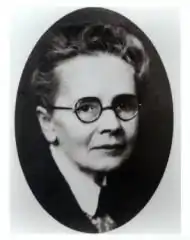 Julia Morgan in 1926 | |
| Born | January 20, 1872 |
| Died | February 2, 1957 (aged 85) |
| Nationality | American |
| Alma mater | University of California, Berkeley |
| Occupation | Architect |
| Awards | AIA Gold Medal |
| Buildings | Los Angeles Examiner Building The YWCA in Chinatown, San Francisco Riverside Art Museum Asilomar Conference Grounds |
| Projects | Hearst Castle |
Morgan was the first woman to be admitted to the architecture program at l'École nationale supérieure des Beaux-Arts[1] in Paris and the first woman architect licensed in California. She designed many edifices for institutions serving women and girls, including a number of YWCAs and buildings for Mills College.
In many of her structures, Morgan pioneered the aesthetic use of reinforced concrete, a material that proved to have superior seismic performance in the 1906 and 1989 earthquakes.[4] She embraced the Arts and Crafts Movement and used various producers of California pottery to adorn her buildings. She sought to reconcile classical and Craftsman, scholarship and innovation, formalism and whimsy.[5]
Julia Morgan was the first woman to receive American Institute of Architects’ highest award, the AIA Gold Medal, posthumously in 2014.[6]
Early life and education
Morgan, the daughter of Charles Bill Morgan and Eliza Woodland Parmelee Morgan, was born on January 20, 1872, the second of five children. Her mother, Eliza, grew up as the indulged daughter of Albert O. Parmelee, a cotton trader and millionaire who financially supported the couple when they moved to San Francisco.[7] Two years after their daughter's birth, the Morgans moved to a home they had built in the suburb of Oakland. Though the Morgans resided on the West Coast, Eliza still kept close ties with her family. Upon the birth of each Morgan child, the Parmalees sent funds for the family to travel by the transcontinental railroad so that the infant could be christened in the traditional Parmelee family church in New York.[8]
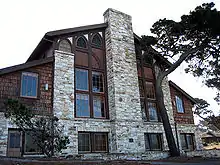
Charles Morgan, a mining engineer from New England who had married into a wealthy family, did not succeed in any of his business ventures, so the family relied heavily on the Parmelee fortune. In mid-1878, Eliza took the children to New York to live near the Parmelees for a year while Charles worked in San Francisco. In New York, Julia met her older cousin Lucy Thornton, who was married to successful architect Pierre Le Brun. After returning to Oakland, Julia kept in contact with Le Brun; he encouraged her to pursue a higher education. In New York, Julia had been sick with scarlet fever and was kept in bed for a few weeks. As a result of this illness, she was prone to ear infections[8] throughout her adult life. Upon the death of Albert Parmelee in July of 1880, and Julia's grandmother moved into the Oakland house, bringing with her the Parmelee wealth. Both Julia's mother and grandmother provided strong female role models, who because of their wealth had a strong degree of power in the Morgan household.[9]
Morgan graduated from Oakland High School in 1890. She was dedicated to her education and a professional career in architecture. She enrolled in the University of California, in nearby Berkeley, where she studied Engineering, as there was no architectural program.[10] At the university, she was a member of the Kappa Alpha Theta sorority and was often the only woman in her math, science, and engineering courses. She graduated from Berkeley in 1894 with a B.S. degree with honors in civil engineering. After her graduation, Morgan became a member of the Association of Collegiate Alumnae, now the American Association of University Women.
One of the engineering lecturers of her senior year was Bernard Maybeck, an eccentrically dressed architect who designed buildings that Morgan admired for their respect for the surrounding topography and environment. Maybeck mentored Morgan, along with her classmates Arthur Brown, Jr., Edward H. Bennett and Lewis P. Hobart, in architecture at his Berkeley home. He encouraged Morgan to continue her studies at the prestigious École nationale supérieure des Beaux-Arts in Paris where he had distinguished himself. After graduating in 1894, Morgan gained a year of work experience building with Maybeck, then traveled to Paris in 1896 to prepare for the Beaux-Arts entrance exam. The school had never before allowed a woman to study architecture, but in 1897, it opened its entry process to women applicants, largely because of pressure from a union of French women artists, whom Morgan characterized as "bohemians."[9][11] Morgan met with these women and was exposed to their feminist views; they discussed how to increase the influence of women in professional careers.
In principle, the school admitted the top 30 candidates. It took Morgan three tries to get in: on the first try, she placed too low, while on her second try, in 1898, although she placed well into the top 30, the examiners "arbitrarily lowered" her marks.[11][12] After more than a year of further study, tutored by François-Benjamin Chaussemiche, a winner of the Prix de Rome, she finally passed the entrance exams in the Architecture Program, placing 13th out of 376 applicants, and was duly admitted.[11] However, she could study only until her 30th birthday, as the school prohibited older scholars. In early 1902, as her birthday approached, Morgan submitted an outstanding design for a palatial theater. This earned her a certificate in architecture, making her the first woman to receive one from the school; she did so in three years, although the usual time of completion was five years (that was how long Maybeck took, for example).[9][11][13] She stayed in Paris long enough to collaborate with Chaussemiche on a project for Harriet Fearing, an ex–New Yorker who contracted for a "grand salon" design for her residence in Fontainebleau.[2]
Career
Upon her return from Paris, Morgan took employment with San Francisco architect John Galen Howard, who was supervising the University of California Master Plan. Morgan worked on several buildings on the Berkeley campus, providing the decorative elements for the Hearst Mining Building and an early proposal for Sather Gate. She was the primary designer for the Hearst Greek Theatre.[9] Howard told a colleague that Morgan was "an excellent draftsman whom I have to pay almost nothing, as it is a woman."[2] She saved her money and made plans to work on her own, accepting important side projects.[9]
In 1904, Morgan was the first woman to obtain an architecture license in California. While living at the old family home in Oakland, she opened her own office in San Francisco, where the staff knew her as 'J.M.' After her first office was destroyed by the 1906 fire, she opened her office in 1907 on the 13th floor of the Merchants Exchange Building, 465 California Street, in the heart of San Francisco's financial district, where she worked for the rest of her career. Between the years of 1907 and 1910, she partnered with Ira Hoover, former draftsman of Howard. Morgan reestablished an individual private practice in late 1910.
In April 1904, Julia Morgan completed her first reinforced concrete structure, the 72-foot bell tower at Mills College, El Campanil,[14] which is located across the bay from San Francisco. Two years later, El Campanil survived the 1906 San Francisco earthquake unscathed without any damage, which helped build her reputation and launch her career.[15]
The devastation of the San Francisco earthquake in 1906 provided her with the opportunity to design numerous homes, churches, offices, and educational facilities.[16] An important project was the redesign of the landmark Fairmont Hotel in San Francisco after its interior was severely damaged by fire after the earthquake of 1906. She was chosen because of her then-rare knowledge of earthquake-resistant, reinforced concrete construction. Her work on restoring the Fairmont in less than a year brought her a national reputation as "a superb engineer, an innovative designer and architect, and a dedicated professional."[11]:20 The marked increase in commissions following the 1906 San Francisco earthquake brought her financial success.[2]
”My work here [Fairmont Hotel] has all been structural.” —Julia Morgan (1907)
Greatly impressed by her work on the Fairmont, Phoebe Hearst recommended Morgan for several large construction projects, including Asilomar. Her son, William Randolph Hearst, was likewise greatly impressed and, after his mother's death, retained Morgan to design what would become the biggest and most famous project of her career, Hearst Castle.[11]:22
Hearst projects
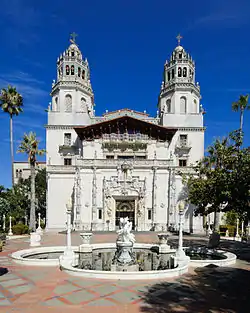 The Hearst Castle facade.
The Hearst Castle facade..jpg.webp) Indoor Roman pool on Hearst Castle grounds (empty)
Indoor Roman pool on Hearst Castle grounds (empty).jpg.webp) Hearst Castle outdoor Neptune pool view
Hearst Castle outdoor Neptune pool view
Julia Morgan involvement with the Hearst family went on for three generations. Her first architecturally related project was commissioned by the family in 1902, when she returned from the Ecole. Her first commission by the family was Phoebe Apperson Hearst's Hacienda at Pleasanton.[17] Morgan's most famous patron was the newspaper magnate and antiquities collector William Randolph Hearst, who had been introduced to Morgan by his mother Phoebe Apperson Hearst, the chief patron of the University of California at Berkeley. It is believed that this introduction led to Morgan's first downstate commission by Hearst for the design of the Los Angeles Examiner Building (circa 1914), a Mission revival style project that included contributions by Los Angeles architects William J. Dodd and J. Martyn Haenkel. It is located at the southwest corner of Broadway and 11th Streets on a city block in Downtown Los Angeles, awaiting adaptive reuse.
In 1919, Hearst selected Morgan as the architect for La Cuesta Encantada, better known as Hearst Castle, which was built atop the family campsite overlooking San Simeon Harbor. Morgan employed tiles, designing many of them herself, from California Faience.[18]
The project proved to be her largest and most complex, as Hearst's vision for his estate grew ever grander over the decades of planning and construction. The project included The Hacienda, a residence–private guest house complex built in hybrid Mission Revival, Spanish Colonial Revival (working with Hispanic experts Mildred Stapley and Arthur Byne), and Moorish Revival styles. It was located a day's horseback ride inland from Hearst Castle, next to the Mission San Antonio de Padua near Jolon, California. Her work on 'the Castle' and San Simeon Ranch continued until 1947, ended only by Hearst's declining health.
Morgan became William Randolph Hearst's principal architect, producing the designs for dozens of buildings, such as Phoebe Apperson Hearst's Wyntoon, which he inherited. The estate includes a castle and "Bavarian village" of four villas, all on 50,000 acres (202 km2) of forest reserve that includes the McCloud River near Mount Shasta in Northern California. She also did studio and site work for the uncompleted Babicora, Hearst's 1,625,000-acre (6,580 km2) Chihuahua, Mexico, cattle rancho and retreat.[19]
YWCA projects
.JPG.webp)
Julia Morgan's affiliation with the YWCA began when Phoebe Apperson Hearst recommended her for the organization's Asilomar summer conference center, a project she began in 1913. The Asilomar Conference Center, no longer YWCA but State-run, is still in Pacific Grove near Monterey, California. Morgan also designed YWCAs in California, Utah, Arizona, and Hawaii.
Five of the Southern California YWCA buildings were designed by Morgan.[20] The 1918 Harbor Area YWCA (San Pedro, CA) in a Craftsman building is still standing, as is the 1926 Hollywood Studio Club YWCA. Morgan's Riverside YWCA from 1929 still stands, but as the Riverside Art Museum. Her 1925 Long Beach Italian Renaissance branch has been demolished. The "gorgeous" Pasadena YWCA is being acquired by the City for restoration and public use after several decades of decay.[20]
She also designed YWCAs in Northern California, including those in Oakland and in San Francisco's Chinatown. The YWCA building in San Francisco reflects her understanding of traditional Chinese architecture. The building was restored in 2001 by the Chinese Historical Society of America (CHSA), and now houses the Chinese Historical Society of America Museum and Learning Center.
Mills College
Morgan made many architectural contributions to the women's college Mills College in the East Bay foothills of Oakland, California. Like her work for the YWCA, they were done in the hopes of advancing opportunities for women.
Mills president Susan Mills became interested in Morgan in 1904 because she wished to further the career of a female architect and because Morgan, just beginning her career, charged less than her male counterparts.[21] Morgan designed six buildings for the Mills campus, including El Campanil, believed to be the first bell tower on a United States college campus.[21] El Campanil should not be confused with The Campanile, a nickname for Sather Tower, the clock/bell tower of nearby UC Berkeley. Morgan helped draft parts of the UC Berkeley campus under John Galen Howard, but the Sather Tower was not her design.
Morgan's reputation grew when the tower was unscathed by the 1906 San Francisco earthquake.[21] The bells in the tower "were cast for the World's Columbian Exposition (Chicago-1893), and given to Mills by a trustee".[22]
Morgan also designed the Margaret Carnegie Library (1906), named after Andrew Carnegie's daughter,[21] and the Ming Quong Home for Chinese girls, built in 1924 and purchased for Mills in 1936.[22] It was eventually renamed Alderwood Hall, before becoming the Julia Morgan School for Girls in 2004[21] (independent of the College). Morgan designed the Mills College Student Union in 1916.[21] Morgan's Kapiolani Cottage has served as an infirmary, faculty housing, and administration offices.[21][22] Morgan also designed the original gymnasium and pool, since replaced by the Tea Shop and Suzanne Adams Plaza,[21] the first reinforced concrete structure on the west coast.[22]
Other projects
.JPG.webp)
Among her earliest works was the North Star House in Grass Valley, California, commissioned in 1904-5 by mining engineer Arthur De Wint Foote and his wife, the author and illustrator Mary Hallock Foote.
She considered St. John's Presbyterian Church, in Berkeley, California, her finest Craftsman-style building.[23] It is now the Berkeley Playhouse.[24]
Other projects include the Chapel of the Chimes in Oakland; the nearby brick multi-use building at 4021 Piedmont Avenue; the sanctuary of Ocean Avenue Presbyterian Church at 32 Ocean Avenue, San Francisco (where Mission Bay Community Church also meets); and the large Berkeley City Club adjacent to University of California. She designed the World War I YWCA Hostess House in Palo Alto, built in 1918 and later to become the site of the MacArthur Park Restaurant[25]
Some of her residential projects, most of them located in the San Francisco Bay Area, are ultimate bungalows. The style is often associated with the work of Greene and Greene and some of Morgan's other contemporaries and teachers. The buildings represent the Arts and Crafts Movement and the American Craftsman style of architecture. Several houses are on San Francisco's Russian Hill. She lived further west in SF. One of Morgan’s first residential project was to remodel and complete Phoebe Hearst’s Hacienda del Pozo de Verona in Pleasanton, California, in Mediterranean and California Mission style. In 1908, Julia Morgan designed the residence of James Henry Pierce at 1650 The Alameda in San Jose, which features rare California timber.[26]
_-_1.JPG.webp)
Personal life
Although Morgan was highly respected as an architect, not much is known about her personal life. She was never married and had no known romances. She kept a low profile and lived modestly, in spite of her wealthy clientele. She gave no interviews and did not write about herself. She worked tirelessly on minimal sleep and food.[3]
She was very independent. During her transition to Paris she had a set of money given to her by her parents for all of her first-year expenses. Even when her funds ran out, she never asked her family for any extra money, but instead learned to live on a tight budget. This experience gave her a concrete understanding of how to handle money efficiently, which helped make her a successful businesswoman after she opened her own practice, and helped her to focus on keeping her projects within her clients budgets.[27]
One of the few public awards she accepted was the University of California, Berkeley, honorary Doctor of Laws degree, its highest award, conferred upon her on May 15, 1929, with the following personal tribute: “distinguished alumna of the University of California, artist and engineer; designer of simple dwellings and of stately homes, of great buildings nobly planned to further the centralized activities of her fellow citizens; architect in whose works harmony and admirable proportions bring pleasure to the eye and peace to the mind.”[28]
Intrigued with the gaps in Julia Morgan's life story, Belinda Taylor, wrote "Becoming Julia Morgan", a 2012 play in which Taylor imagines a plausible life story for Morgan.[29]
"My buildings will be my legacy... they will speak for me long after I'm gone." --Julia Morgan
Legacy
Julia Morgan is buried in the Mountain View Cemetery in the hills of Oakland, California.[30]
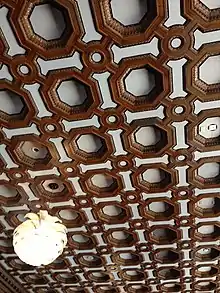
In 1995, the Julia Morgan Ballroom at the Merchants Exchange Building in San Francisco, where she had her office from 1907 to 1950, was named in her honor.[31]
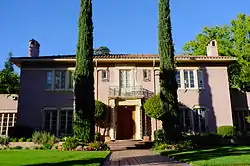
In 1999, a Mediterranean Revival residence originally built in 1918 for Charles Goethe of Sacramento was renamed the Julia Morgan House. It was earlier added to the National Register of Historic Places in 1982.
In 2006, a children's picture book titled Julia Morgan Built a Castle was published and is available in many public libraries. [32]
On May 28, 2008, California Governor Arnold Schwarzenegger and First Lady Maria Shriver announced that Julia Morgan would be inducted into the California Hall of Fame, located at The California Museum for History, Women and the Arts. The induction ceremony took place on December 15 and her great-niece accepted the honor in her place.[33]
Julia Morgan was the 2014 recipient (posthumous) of the AIA Gold Medal, the highest award of the American Institute of Architects (AIA). She is the first female architect to receive this honor.[34]
Further reading
- Books
- Boutelle, Sara Holmes (1988). Julia Morgan, Architect. New York: Abbeville Press.
- Harris, Gloria G.; Hannah S. Cohen (2012). "Chapter 9. Architets". Women Trailblazers of California: Pioneers to the Present. Charleston, SC: The History Press. pp. 136–50 [137–40]. ISBN 978-1609496753.
- Lewis, Anna M. (2014). Women of Steel and Stone: 22 Inspirational Architects, Engineers, and Landscape Designers. Chicago, IL: Chicago Review Press. p. 88. ISBN 978-1-61374-511-3.
- Morgan, J. (1976). Architectural drawings by Julia Morgan: beau-arts assignments and other buildings. Oakland, Calif: Oakland Museum, Art Dept.
- Morgan, J., Hearst, W. R., & Loe, N. E. (1987). San Simeon revisited: the correspondence between architect Julia Morgan and William Randolph Hearst. San Luis Obispo, Calif: Library Associates, California Polytechnic State University.
- Morgan, J. (1987). Berkeley houses by Julia Morgan. Berkeley, California: The Association.
- Perry, Phillis J. (2018). All About Julia Morgan. Indianapolis, Indiana, Blue River Press ISBN 978-1681570952
- Reviews
- Kastner, Victoria. (2003). "Morgan and Associates: Julia Morgan's Office Practice as Design Metaphor." 20 on 20/20 Vision. Boston: AIA Diversity Committee/Boston Society of Architects, pp. 44-51.
- Longstreth, R. W. (1977). Julia Morgan, architect. Berkeley Architectural Heritage publication series, no. 1. Berkeley, California: Berkeley Architectural Heritage Association.
- McNeill, Karen (May 2007) "Julia Morgan: Gender, Architecture, and Professional Style." Pacific Historical Review, pp. 229–67.
- McNeill, Karen (Summer 2012) "'Women Who Build: Julia Morgan & Women's Institutions." California History, pp. 41–74.
- Pasadena Cultural Heritage Commission. (1988). Report on reuse of the Julia Morgan YWCA building: YWCA & YMCA Pasadena, California. New York: Halsband.
- Quacchia, R. L. (2005). Julia Morgan, architect, and the creation of the Asilomar Conference Grounds: including a comparison with Hearst Castle. Virginia Beach, Virginia: Q Pub.
- Steilberg, W. T., & Morgan, J. (1983). Some examples of the work of Julia Morgan. San Francisco: Architect and Engineer of California.
- University of California, Berkeley. (1986). Julia Morgan, architectural drawings: inventory of holdings, College of Environmental Design. Berkeley: The College.
See also
References
- (fr) Agorha.inha, Biographie rédigée par Marie-Laure Crosnier Leconte
- Boutelle, Sara Holmes (March–April 1996). "Julia Morgan, Engineer and Architect". Old-House Journal. Active Interest Media. 24 (2): 22. ISSN 0094-0178.
- Erica Reder: "Julia Morgan was a local, in The New Fillmore, 1 February 2011. Retrieved 2015-10-23.
- Littman, Julie (March 7, 2018). "Bay Area Architect Julia Morgan's Legacy Wasn't Just Hearst Castle". busnow.com. Retrieved 18 April 2019.
- Starr, Kevin (1997). The dream endures: California enters the 1940s. New York: Oxford University Press. pp. 55. ISBN 978-0195100792. OCLC 34546312.
- Wendy Moonan: "AIA Awards 2014 Gold Medal to Julia Morgan", in the Architectural Record, 16 December 2013
- Rochlin, Harriet (March 1976). "Designed by Julia Morgan". Westways. Automobile Club of Southern California. 68 (3): 26–29, 75–76, 80.
- Wadsworth, Ginger (1990). Julia Morgan, Architect of Dreams. Twenty-First Century Books. pp. 8–11. ISBN 978-0-8225-4903-1.
- McNeill, Karen (Summer 2012). "'Women Who Build': Julia Morgan & Women's Institutions" (PDF). California History. California Historical Society. 89 (3): 41–74. doi:10.2307/23215875. JSTOR 23215875. Archived from the original (PDF) on 2015-09-23. Retrieved 2012-07-22.
- Boutelle, Sara Holmes (1995). Julia Morgan, architect. Morgan, Julia, 1872–1957 (Revised and updated edition, 1995 ed.). New York. ISBN 078-9200848. OCLC 33265537.
- Wilson, Mark Anthony (2007). Julia Morgan: Architect of Beauty. Layton, Utah: Gibbs Smith. pp. 3–5. ISBN 978-1-4236-0088-6.
- Reichers, Maggie (September–October 2006). "Beyond San Simeon". Humanities. Neh.gov. 27 (5). Archived from the original on 2012-02-22. Retrieved 2012-09-07.
- "Julia Morgan: Early Architect. California State Capitol website". Archived from the original on June 23, 2007. Retrieved 2009-05-26., Retrieved 2009-05-26
- "El Campanil, Mills College: Julia Morgan 1903–1904". Retrieved 18 April 2019.
- Callen, Will (February 4, 2019). "Julia Morgan-designed Mills bell tower counts down to its 115th anniversary". hoodline.com. Retrieved 18 April 2019.
Morgan had studied the material in Paris, where some of its pioneers, François Hennebique and Auguste Perret, were exploring its non-industrial uses. Fascinated by its combination of stability and plasticity, she may have been the first architect in the U.S. to put it towards something other than bridges or piers.
- Morgan, Julia. "Julia Morgan". Encyclopedia Britannica.
- Boutelle, Sara Holmes (February 2000). "Morgan, Julia (1872–1957), architect". American National Biography Online. Oxford University Press. doi:10.1093/anb/9780198606697.article.1700602. Cite journal requires
|journal=(help) - Berkeley Bohemia: Artists and Visionaries of the Early 20th Century. 2008. p. 132.
The company was chosen by the castle's architect, Julia Morgan, who personally designed many of the tiles that were made
- "Babicora, Mexico: End of An Empire". Time. 7 September 1953. Retrieved May 11, 2010.
- Bariscale, Floyd B. (October 1, 2008). "No. 186 – Morgan House (Harbor Area YWCA)". Big Orange Landmarks. Retrieved May 11, 2010.
- Ito, Susan (Winter 2004). "Julia Morgan at Mills". Mills Quarterly. Mills College. p. 14. Retrieved 2020-11-18.
- Mills College 2007/2008 Undergraduate Student Handbook (PDF). School Datebooks. 2007. Retrieved 2008-02-27.
- "An Architect from the Inside Out, Los Angeles Times, September 4, 1988
- Thompson, Daniella. "Berkeley Landmarks: St. John's Presbyterian Church". Berkeley Architectural Heritage Association. Retrieved 2012-09-07.
- "MacArthur Park". Macpark.com. Retrieved 2012-09-07.
- "San Jose's Julia Morgan House" (PDF). Continuity: 11. Summer 2009.
- Wilson, Mark Anthony (2007). Julia Morgan Architect of Beauty. Utah: Gibbs Smith. pp. 1, 4.
- McNeill, Karen (May 2007). "Julia Morgan: Gender, Architecture, and Professional Style". Pacific Historical Review. 76 (2): 229–68. doi:10.1525/phr.2007.76.2.229. JSTOR 10.1525/phr.2007.76.2.229.
- Erica Reder, ed. (2012). "Belinda Taylor presents: Becoming Julia Morgan". Archived from the original on July 22, 2018.
- Mountain View Cemetery
- "About the Historic Julia Morgan Ballroom Event Space in San Francisco". Julia Morgan Ballroom. Retrieved 2018-02-10.
- Mannis, Celeste Davidson (2006). Julia Morgan built a castle. Hyman, Miles. New York, N.Y.: Viking. ISBN 978-0670059645. OCLC 56051019.
- "Governor & First Lady Participate in 2008 CA Hall of Fame Induction Ceremony". State of California, Office of Governor. Archived from the original on 2015-06-02. Retrieved 2013-05-20.
- "2014 AIA Gold Medal Awarded to Julia Morgan, FAIA". Press Releases. American Institute of Architects. Retrieved 12 December 2013.
External links
| Wikimedia Commons has media related to Julia Morgan. |
- The Julia Morgan Collection at Cal Poly San Luis Obispo
- Julia Morgan – An Online Exhibition
- Julia Morgan Collection at the Environmental Design Archives
- Hidden Engineer: The Designs of Julia Morgan
- Julia Morgan Architectural Drawings, 1907–1929, The Bancroft Library
- Index of Buildings by Julia Morgan
- Julia Morgan, Beverly Willis Architecture Foundation Dynamic National Archive at Archive.today (archived December 12, 2013)
- One Woman’s Contribution to Arts and Crafts Architecture
- Julia Morgan "Spotlight on Women in Design"
- Julia Morgan 2012
- Morgan (Julia) Collection, 1893–1980
.JPG.webp)